
This article mainly introduces Pages and form validation about Laravel 4. It has certain reference value. Now I share it with you. Friends in need can refer to it.
This tutorial is the end of this series. In this article, what we need to do is the detailed management functions of Pages, form validation and in-depth use of namespaces, and a better-use notification component, and arrange a simple big job.
1. Build Pages management function
Run command:
php artisan generate:controller admin/PagesController
Modify PagesController.php content:
<?php
namespace App\Controllers\Admin;
use Page;
use Input, Notification, Redirect, Sentry, Str;
use App\Services\Validators\PageValidator;
class PagesController extends \BaseController {
public function index()
{
return \View::make('admin.pages.index')->with('pages', Page::all());
}
public function show($id)
{
return \View::make('admin.pages.show')->with('page', Page::find($id))->withAuthor(Sentry::findUserById(Page::find($id)->user_id)->name);
}
public function create()
{
return \View::make('admin.pages.create');
}
public function store()
{
$validation = new PageValidator;
if ($validation->passes())
{
$page = new Page;
$page->title = Input::get('title');
$page->body = Input::get('body');
$page->user_id = Sentry::getUser()->id;
$page->save();
Notification::success('新增页面成功!');
return Redirect::route('admin.pages.edit', $page->id);
}
return Redirect::back()->withInput()->withErrors($validation->errors);
}
public function edit($id)
{
return \View::make('admin.pages.edit')->with('page', Page::find($id));
}
public function update($id)
{
$validation = new PageValidator;
if ($validation->passes())
{
$page = Page::find($id);
$page->title = Input::get('title');
$page->body = Input::get('body');
$page->user_id = Sentry::getUser()->id;
$page->save();
Notification::success('更新页面成功!');
return Redirect::route('admin.pages.edit', $page->id);
}
return Redirect::back()->withInput()->withErrors($validation->errors);
}
public function destroy($id)
{
$page = Page::find($id);
$page->delete();
Notification::success('删除成功!');
return Redirect::route('admin.pages.index');
}
}Then, open http://localhost:8000/admin page, log in with the account and password that was seeded before, we will get an error:
Class App\Controllers\Admin\PagesController does not exist
This file obviously already exists, why does Laravel report an error saying it does not exist? ! The reason is in the second tutorial, so I will explain it directly here. Because this class is not in the top-level namespace, and we did not tell Laravel that we have added a new class in the sub-namespace. Let’s tell it now:
composer dump-autoload
OK, refresh, we will get the following error again:
View [admin.pages.index] not found.
At this time, copy the entire pages folder in my view.
refresh. You will get the following error:
Class 'Notification' not found
This is because we have not installed the composer package, edvinaskrucas/notification, please install version 3.0.1 yourself (4 is prepared for Laravel 5), this is the third one Small homework. It must be placed in require. The packages in require-dev are only used during development.
The Notification here is the more useful notification component.
After this is packaged, run:
composer dump-autoload
Then add the following two lines at the appropriate location in config/app.php:
'Krucas\Notification\NotificationServiceProvider'
'Notification' => 'Krucas\Notification\Facades\Notification'
Appropriate location Many people don't understand, which leads to many people making mistakes. The solution is also very simple.
Refresh, if you see the following interface:

Congratulations~ The management page of Pages is completed!
2. Form Validation
Laravel provides a native and very easy-to-use form validation function, but sometimes validation rules need to be reused, so we will use the powerful Namespaces are used to achieve code reuse, and at the same time, it will demonstrate the powerful componentization functions and module decoupling brought by PHP namespaces outside of Laravel. HMVC has fallen behind.
Create a new app/services/validators two-level folder, and add it in composer.json's autoload > classmap at the end:
"app/services"
This is telling composer: Come and add all the following to me Merge all files in files and subfolders into your namespace tree! This allows classes under app/services to declare their own namespace, and files in subfolders can also declare that they belong to the subnamespace. This folder will host our form validation cluster, and of course many other components and modules, allowing for complete decoupling.
After the addition is completed, create a new app/services/validators/Validator.php file:
<?php
namespace App\Services\Validators;
abstract class Validator {
protected $data;
public $errors;
public static $rules;
public function __construct($data = null)
{
$this->data = $data ?: \Input::all();
}
public function passes()
{
$validation = \Validator::make($this->data, static::$rules);
if ($validation->passes()) return true;
$this->errors = $validation->messages();
return false;
}
}Create a new app/services/validators/PageValidator.php file:
<?php
namespace App\Services\Validators;
class PageValidator extends Validator {
public static $rules = array(
'title' => 'required',
'body' => 'required',
);
}Then run :
composer dump-autoload
At this time, you can try all the operations on the entire page! Create, edit, view, delete. At this point, the pages management part is complete!
Big job: At present, the Pages management part has been completed, but the Articles management part still has nothing. Try to imitate the code of Pages and complete a management system like Pages. Tip: Include controller, view and form validation. Once you have completed the Articles management part, you will really get started with Laravel!
The above is the entire content of this article. I hope it will be helpful to everyone's study. For more related content, please pay attention to the PHP Chinese website!
Related recommendations:
Use Laravel to generate Gravatar avatar address
How to solve the problem of Laravel's throttle middleware failure
How to use the mb_detect_encoding function in PHP
##
The above is the detailed content of Pages and form validation for Laravel 4. For more information, please follow other related articles on the PHP Chinese website!




